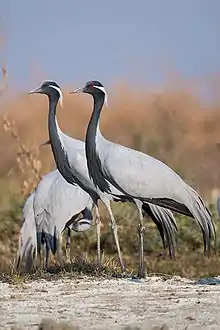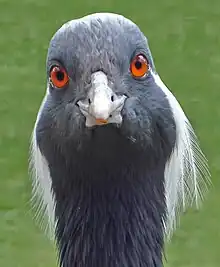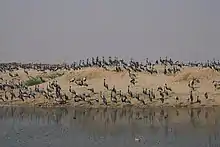| Demoiselle crane | |
|---|---|
 | |
| Flock at Tal Chhapar Sanctuary, Churu, Rajasthan | |
| Scientific classification | |
| Domain: | Eukaryota |
| Kingdom: | Animalia |
| Phylum: | Chordata |
| Class: | Aves |
| Order: | Gruiformes |
| Family: | Gruidae |
| Genus: | Grus |
| Species: | G. virgo |
| Binomial name | |
| Grus virgo | |
 | |
| Range of G. virgo Breeding Passage Non-breeding | |
| Synonyms | |
| |
The demoiselle crane (Grus virgo) is a species of crane found in central Eurosiberia, ranging from the Black Sea to Mongolia and Northeast China. There is also a small breeding population in Turkey. These cranes are migratory birds. Birds from western Eurasia will spend the winter in Africa while the birds from Asia, Mongolia and China will spend the winter in the Indian subcontinent. The bird is symbolically significant in the culture of India, where it is known as Koonj or Kurjaa.[3]
Description

The demoiselle is 85–100 cm (33.5–39.5 in) long, 76 cm (30 in) tall and has a 155–180 cm (61–71 in) wingspan. It weighs 2–3 kg (4.4–6.6 lb). It is the smallest species of crane.[4][5] The demoiselle crane is slightly smaller than the common crane but has similar plumage. It has a long white neck stripe and the black on the foreneck extends down over the chest in a plume.
It has a loud trumpeting call, higher-pitched than the common crane. Like other cranes it has a dancing display, more balletic than the common crane, with less leaping.
The demoiselle was so named by Queen Marie Antoinette, for its delicate and maiden-like appearance.[6]
In culture
.jpg.webp)
The demoiselle crane is known as the Koonj /Kurjan(कूंज,कुरजां کونج, ਕੂੰਜ) in the languages of North India and in Urdu in Pakistan, and figure prominently in the literature, poetry and idiom of the region. Beautiful women are often compared to the koonj because its long and thin shape is considered graceful. Metaphorical references are also often made to the koonj for people who have ventured far from home or undertaken hazardous journeys.[7]

The name koonj is derived from the Sanskrit word kraunch, which is a cognate Indo-European term for crane itself.[3] In the ancient story of Valmiki, the composer of the Hindu epic Ramayana, it is claimed that his first verse was inspired by the sight of a hunter kill the male of a pair of demoiselle cranes that were courting. Observing the lovelorn female circling and crying in grief, he cursed the hunter in verse. Since tradition held that all poetry prior to this moment had been revealed rather than created by man, this verse concerning the demoiselle cranes is regarded as the first human-composed meter.[8]
The flying formation of the koonj during migrations also inspired infantry formations in ancient India. The Mahabharata epic describes both warring sides adopting the koonj formation on the second day of the Kurukshetra War.[9]
References
- ↑ BirdLife International (2018). "Anthropoides virgo". IUCN Red List of Threatened Species. 2018: e.T22692081A131927771. doi:10.2305/IUCN.UK.2018-2.RLTS.T22692081A131927771.en. Retrieved 14 February 2022.
- ↑ "Appendices | CITES". cites.org. Retrieved 2022-01-14.
- 1 2 R. K. Gaur (1994), Indian birds, Brijbasi Printers, 1994, ISBN 9788171070312,
... The smallest member of the crane family, the demoiselle crane (Anthropoides virgo ) is a distinctive looking bird, with ashy grey ... The local name for this crane — koonj — is onomatopoeic, deriving from the Sanskrit 'kraunch', the origin of the word crane itself ...
- ↑ Demoiselle Crane, Int. Crane Foundation
- ↑ Ali, S. (1993). The Book of Indian Birds. Bombay: Bombay Natural History Society. ISBN 978-0-19-563731-1.
- ↑ "Demoiselle Crane | International Crane Foundation". www.savingcranes.org. Retrieved 2018-10-22.
- ↑ Department of English, University of Delhi (September 2005). The Individual and Society. Pearson Education India, 2005. ISBN 978-81-317-0417-2.
... kunj: more properly koonj is a demoiselle crane. The word is used metaphorically for a young bride far from her home ...
- ↑ Dinkar Joshi; Yogesh Patel (2005). Glimpses of Indian Culture. Star Publications, 2005. ISBN 978-81-7650-190-3.
... Valmiki saw a pair of kraunch (cranes) birds making love. Suddenly, a hunter killed the male kraunch with an arrow. Valmiki was moved by the cries of the female ... Valmiki's pain was expressed through a shloka ... The first man-composed meter ...
- ↑ Ramesh Menon (20 July 2006). The Mahabharata: A Modern Rendering. iUniverse, 2006. ISBN 978-0-595-40188-8.
... The second day: Two kraunchas ... Yudhishtira decides to form his legions in the vyuha called the krauncha, after the crane ...
External links
- eBird Species Factsheet
- Demoiselle crane at Animal Diversity Web
- Demoiselle Crane (Anthropoides virgo) from Cranes of the World (1983) by Paul Johnsgard
